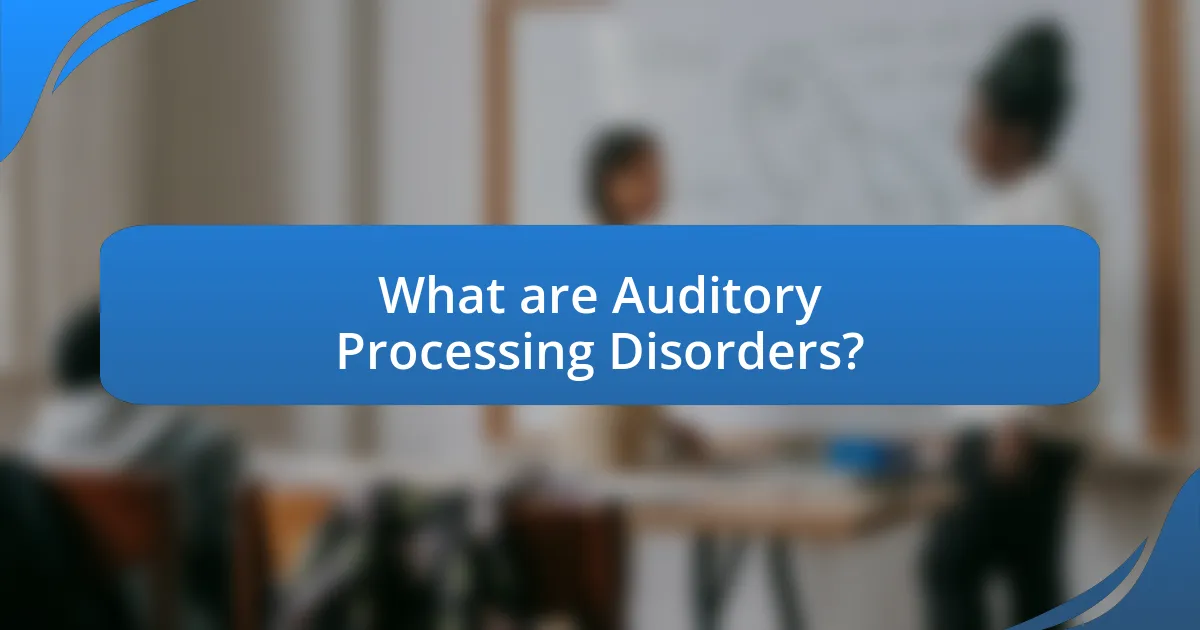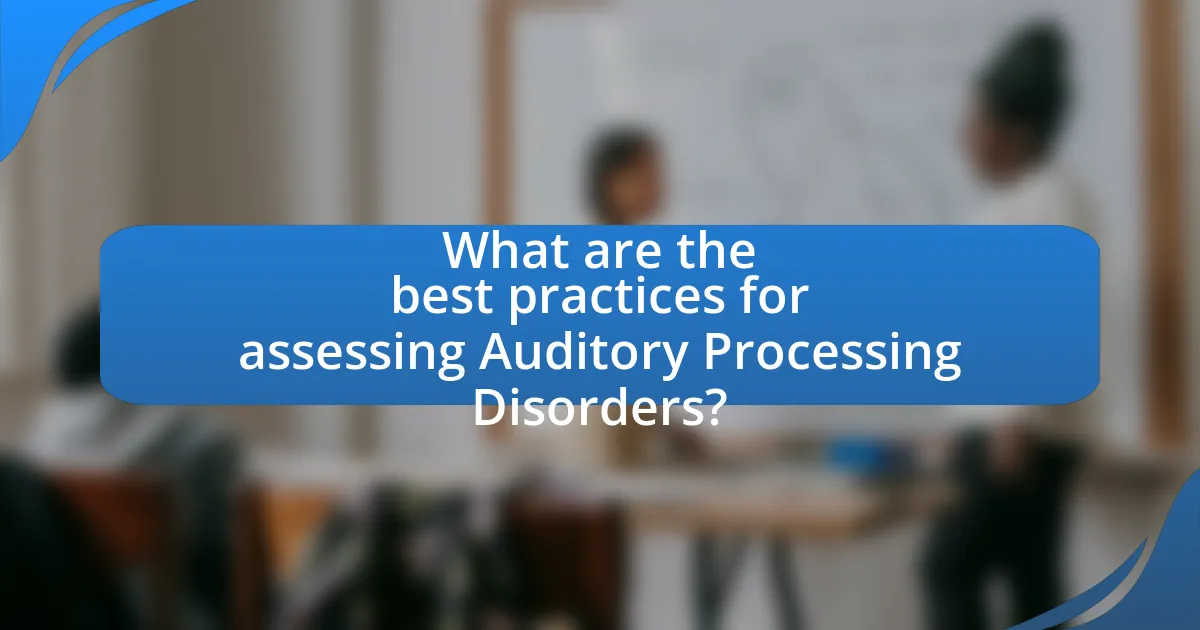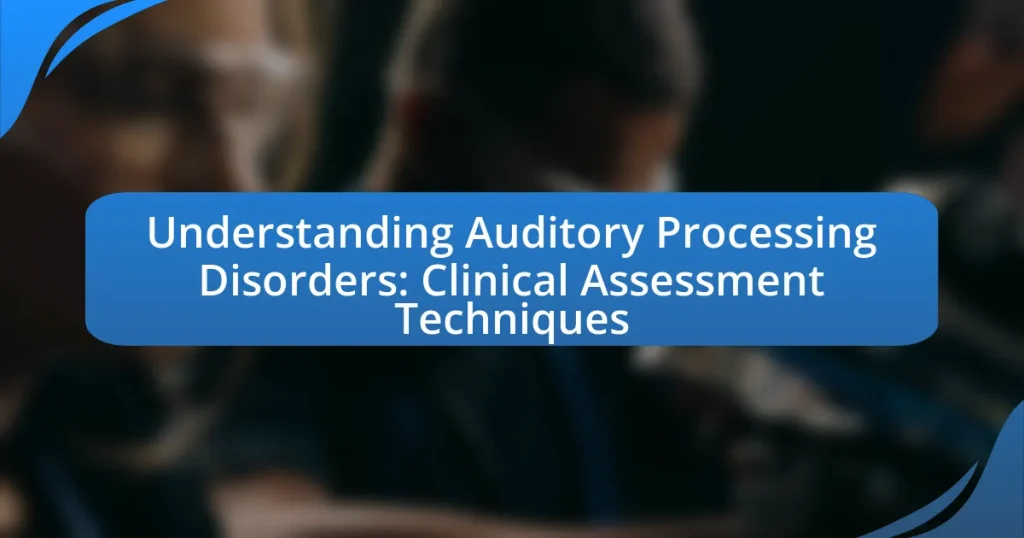Auditory Processing Disorders (APD) are neurological conditions that hinder the brain’s ability to process auditory information, despite normal hearing. This article provides a comprehensive overview of APD, detailing its manifestations, common symptoms, and the impact on individuals across different age groups. It explores the causes of APD, including neurological factors and environmental influences, and emphasizes the importance of early identification and intervention to improve outcomes. Additionally, the article outlines clinical assessment techniques, including standardized tests and observational methods, while addressing the challenges and best practices in diagnosing APD.

What are Auditory Processing Disorders?
Auditory Processing Disorders (APD) are neurological conditions that affect how the brain processes auditory information. Individuals with APD may have normal hearing ability but struggle to understand and interpret sounds, particularly in noisy environments or when multiple sounds occur simultaneously. Research indicates that APD can impact language development, academic performance, and social interactions, as affected individuals may find it challenging to follow conversations or comprehend spoken instructions.
How do Auditory Processing Disorders manifest in individuals?
Auditory Processing Disorders (APD) manifest in individuals through difficulties in processing auditory information, despite normal hearing ability. These challenges can include problems with understanding spoken language, especially in noisy environments, difficulty following multi-step directions, and issues with distinguishing similar sounds or words. Research indicates that individuals with APD may also experience delays in language development and academic performance, particularly in reading and spelling. These manifestations are supported by clinical assessments that reveal discrepancies between an individual’s hearing ability and their performance on auditory tasks, confirming the presence of processing difficulties.
What are the common symptoms associated with Auditory Processing Disorders?
Common symptoms associated with Auditory Processing Disorders (APD) include difficulty understanding spoken language, especially in noisy environments, trouble following verbal instructions, and frequent requests for repetition. Individuals with APD may also exhibit problems with distinguishing similar sounds, difficulty with reading and spelling, and challenges in processing auditory information quickly. Research indicates that these symptoms can significantly impact academic performance and social interactions, as individuals struggle to process auditory information effectively.
How do these symptoms vary across different age groups?
Symptoms of Auditory Processing Disorders (APD) vary significantly across different age groups. In children, symptoms often include difficulties in following verbal instructions, problems with phonemic awareness, and challenges in distinguishing similar sounds. Adolescents may experience issues with listening in noisy environments and may struggle with academic performance due to these auditory challenges. In adults, symptoms can manifest as difficulties in processing complex auditory information, leading to misunderstandings in conversations and challenges in multitasking. Research indicates that age-related changes in auditory processing capabilities can influence symptom presentation, with younger individuals often displaying more pronounced difficulties in sound discrimination and older adults facing challenges related to cognitive decline and auditory memory.
What causes Auditory Processing Disorders?
Auditory Processing Disorders (APD) are primarily caused by neurological differences in how the brain processes auditory information. These differences can stem from various factors, including genetic predispositions, developmental delays, and environmental influences such as chronic ear infections during critical periods of auditory development. Research indicates that children with a history of frequent ear infections may experience disruptions in auditory pathways, leading to difficulties in processing sounds. Additionally, APD can be associated with other conditions like attention deficit hyperactivity disorder (ADHD) and specific language impairment, which further complicate auditory processing abilities.
What are the neurological factors involved in Auditory Processing Disorders?
Auditory Processing Disorders (APD) are influenced by several neurological factors, primarily involving the central auditory nervous system’s ability to process auditory information. Key factors include abnormalities in the auditory cortex, which is responsible for interpreting sounds, and disruptions in the neural pathways connecting the ears to the brain, particularly the corpus callosum, which facilitates communication between the two hemispheres. Research indicates that individuals with APD may exhibit atypical brain activity patterns, as evidenced by studies using functional MRI, which show altered activation in regions associated with auditory processing. Additionally, genetic factors may contribute to the development of APD, as certain hereditary conditions have been linked to auditory processing difficulties.
How do environmental influences contribute to the development of these disorders?
Environmental influences significantly contribute to the development of auditory processing disorders by affecting brain development and auditory processing capabilities. Factors such as exposure to toxins, prenatal substance abuse, and socio-economic conditions can disrupt normal auditory system maturation. For instance, studies have shown that children exposed to lead or other environmental toxins exhibit deficits in auditory processing skills, as these substances can impair neural connectivity and cognitive functions essential for processing auditory information. Additionally, adverse socio-economic conditions can limit access to early intervention services, further exacerbating the risk of developing these disorders.
Why is early identification of Auditory Processing Disorders important?
Early identification of Auditory Processing Disorders (APD) is crucial because it allows for timely intervention, which can significantly improve a child’s communication skills and academic performance. Research indicates that children with APD often struggle with understanding spoken language, which can lead to difficulties in learning and social interactions. By identifying these disorders early, targeted therapies and strategies can be implemented, reducing the risk of long-term educational and social challenges. Studies show that early intervention can enhance auditory skills and overall cognitive development, making it essential for optimal outcomes in affected individuals.
What are the potential long-term effects of undiagnosed Auditory Processing Disorders?
Undiagnosed Auditory Processing Disorders (APD) can lead to significant long-term effects, including academic difficulties, social challenges, and emotional issues. Individuals with undiagnosed APD often struggle with understanding spoken language, which can result in poor academic performance, particularly in reading and language arts. Research indicates that children with APD are at a higher risk for developing learning disabilities, as they may misinterpret or miss critical auditory information necessary for learning (Chermak & Musiek, 2002).
Socially, these individuals may experience difficulties in communication, leading to isolation or challenges in forming relationships. Emotional consequences can include increased anxiety, frustration, and low self-esteem due to ongoing struggles in both academic and social settings. The cumulative impact of these factors can hinder overall development and quality of life.
How can early intervention improve outcomes for individuals with these disorders?
Early intervention can significantly improve outcomes for individuals with auditory processing disorders by providing timely access to targeted therapies and support. Research indicates that early identification and intervention can enhance language skills, academic performance, and social interactions. For instance, a study published in the Journal of Speech, Language, and Hearing Research found that children who received early intervention demonstrated greater improvements in auditory processing abilities compared to those who did not receive such support. This underscores the importance of addressing these disorders promptly to facilitate better developmental trajectories.

What are the clinical assessment techniques for Auditory Processing Disorders?
Clinical assessment techniques for Auditory Processing Disorders (APD) include a variety of standardized tests and behavioral assessments designed to evaluate auditory processing capabilities. These techniques often involve tests such as the Auditory Processing Abilities Test (APAT), the Test of Auditory Processing Skills (TAPS), and the SCAN-3 for Auditory Processing Disorders, which assess skills like auditory discrimination, auditory memory, and auditory sequencing. Research indicates that these assessments can effectively identify deficits in auditory processing, allowing for targeted interventions. For instance, the SCAN-3 has been validated through studies demonstrating its reliability and validity in diagnosing APD in children.
How are Auditory Processing Disorders diagnosed?
Auditory Processing Disorders (APD) are diagnosed through a combination of comprehensive audiological evaluations and specific tests designed to assess auditory processing abilities. Clinicians typically conduct a series of standardized tests, such as the Auditory Processing Assessment Battery (APAB) or the Test of Auditory Processing Skills (TAPS), which measure various aspects of auditory processing, including sound discrimination, auditory memory, and auditory sequencing. These assessments are often supplemented by behavioral observations and questionnaires completed by parents and teachers to gather additional context about the individual’s auditory challenges in everyday situations.
What standardized tests are commonly used in the assessment process?
Standardized tests commonly used in the assessment process for auditory processing disorders include the Central Auditory Processing Test (CAPD), the Auditory Processing Abilities Test (APAT), and the Test of Auditory Processing Skills (TAPS). These tests are designed to evaluate various aspects of auditory processing, such as auditory discrimination, auditory memory, and auditory sequencing. Research indicates that these assessments provide reliable measures of auditory processing capabilities, helping clinicians identify specific deficits and tailor interventions accordingly.
How do clinicians interpret the results of these assessments?
Clinicians interpret the results of auditory processing assessments by analyzing performance patterns across various tasks to identify specific deficits in auditory processing. They compare individual scores to normative data to determine if the results fall within typical ranges or indicate potential auditory processing disorders. For instance, clinicians may look for discrepancies between auditory skills, such as discrimination and memory, to pinpoint areas of difficulty. This methodical approach allows clinicians to develop targeted intervention strategies based on the unique profile of each patient’s auditory processing abilities.
What role do parent and teacher questionnaires play in the assessment?
Parent and teacher questionnaires play a critical role in the assessment of auditory processing disorders by providing valuable insights into a child’s behavior and performance in different environments. These questionnaires gather information on the child’s listening skills, attention, and communication abilities from multiple perspectives, which is essential for a comprehensive evaluation. Research indicates that data collected from parents and teachers can highlight discrepancies between a child’s performance at home and in school, aiding clinicians in identifying specific areas of concern. For instance, studies have shown that parental observations can reveal difficulties in social interactions and academic challenges that may not be evident in clinical settings, thus enhancing the overall assessment process.
How can observational assessments contribute to the diagnosis?
Observational assessments contribute to the diagnosis of auditory processing disorders by providing direct insights into a patient’s behavior and responses in real-time situations. These assessments allow clinicians to evaluate how individuals process auditory information in various contexts, revealing patterns that standardized tests may not capture. For instance, observing a child’s ability to follow verbal instructions in a noisy environment can highlight specific auditory processing challenges, supporting the identification of disorders. Research indicates that observational methods can enhance diagnostic accuracy by integrating behavioral data with clinical findings, thus offering a comprehensive view of the individual’s auditory processing capabilities.
What specific information do questionnaires provide about the individual’s challenges?
Questionnaires provide specific information about an individual’s challenges by assessing their auditory processing abilities, communication skills, and behavioral responses in various listening environments. These tools gather subjective data on how individuals perceive and respond to auditory stimuli, which can highlight difficulties such as trouble following conversations, distinguishing sounds, or processing verbal instructions. Research indicates that questionnaires can reveal patterns of challenges that may not be observable in clinical settings, thus offering insights into the individual’s daily experiences and the impact of auditory processing disorders on their life. For instance, studies have shown that self-reported difficulties in social situations can correlate with formal assessments of auditory processing, validating the effectiveness of questionnaires in identifying specific challenges faced by individuals.
What are the challenges in assessing Auditory Processing Disorders?
Assessing Auditory Processing Disorders (APD) presents several challenges, primarily due to the lack of standardized diagnostic criteria and the variability in symptoms among individuals. The absence of universally accepted assessment tools complicates the identification of APD, as different tests may yield inconsistent results. Additionally, overlapping symptoms with other conditions, such as attention deficit hyperactivity disorder (ADHD) and language disorders, further complicate the diagnostic process. Research indicates that the subjective nature of auditory processing assessments can lead to variability in interpretation, making it difficult for clinicians to arrive at a definitive diagnosis. Furthermore, the reliance on behavioral assessments, which can be influenced by factors such as motivation and attention, adds another layer of complexity to the evaluation of APD.
How can variability in symptoms complicate the assessment process?
Variability in symptoms can complicate the assessment process by making it difficult for clinicians to accurately diagnose auditory processing disorders. This inconsistency in symptom presentation can lead to misinterpretation of the underlying issues, as symptoms may overlap with other conditions such as attention deficit hyperactivity disorder (ADHD) or language disorders. Research indicates that individuals with auditory processing disorders may exhibit a range of symptoms, including difficulties in following verbal instructions, poor listening skills, and challenges in distinguishing similar sounds, which can vary significantly from one individual to another. This variability necessitates a comprehensive assessment approach that includes multiple testing methods and careful observation to ensure accurate diagnosis and effective intervention strategies.
What limitations exist in current assessment techniques?
Current assessment techniques for auditory processing disorders (APD) face several limitations, including variability in test protocols, lack of standardized measures, and potential biases in interpretation. Variability arises because different clinicians may use different tests or procedures, leading to inconsistent results. The absence of standardized measures means that assessments can differ significantly in their reliability and validity, making it difficult to compare results across studies or clinical settings. Additionally, biases in interpretation can occur due to subjective judgments made by clinicians, which may affect the diagnosis and treatment recommendations. These limitations hinder the effectiveness of current assessment techniques in accurately identifying and managing auditory processing disorders.

What are the best practices for assessing Auditory Processing Disorders?
The best practices for assessing Auditory Processing Disorders (APD) include a comprehensive evaluation that combines standardized tests, behavioral assessments, and clinical interviews. Standardized tests, such as the SCAN-3 or the APD Test Battery, provide objective measures of auditory processing abilities. Behavioral assessments involve observing the individual’s responses to auditory stimuli in various listening conditions, which helps identify specific deficits. Clinical interviews with caregivers and teachers gather contextual information about the individual’s auditory challenges in everyday situations. Research indicates that a multi-faceted approach enhances diagnostic accuracy and ensures that all aspects of auditory processing are considered, leading to more effective intervention strategies.
How can clinicians ensure a comprehensive assessment?
Clinicians can ensure a comprehensive assessment by utilizing a multi-faceted evaluation approach that includes standardized tests, clinical interviews, and observational assessments. This method allows for a thorough understanding of the patient’s auditory processing abilities and challenges. Research indicates that combining different assessment tools enhances diagnostic accuracy; for instance, the American Speech-Language-Hearing Association recommends using both behavioral and electrophysiological measures to capture a complete picture of auditory processing disorders. By integrating various assessment techniques, clinicians can identify specific deficits and tailor interventions effectively.
What combination of assessment tools yields the best results?
The combination of assessment tools that yields the best results for evaluating Auditory Processing Disorders (APD) includes a combination of behavioral assessments, electrophysiological tests, and standardized questionnaires. Behavioral assessments, such as the Test of Auditory Processing Skills (TAPS) and the Scales of Early Communication Skills (SECS), provide insights into a child’s auditory processing abilities through direct observation and performance tasks. Electrophysiological tests, like Auditory Brainstem Response (ABR) and Middle Latency Response (MLR), offer objective measurements of auditory function by assessing neural responses to sound stimuli. Standardized questionnaires, such as the Children’s Auditory Processing Scale (CAPS), gather subjective reports from parents and teachers regarding a child’s auditory behaviors in everyday situations. Research indicates that using a multi-faceted approach that incorporates these diverse tools leads to more accurate diagnoses and tailored intervention strategies, as evidenced by studies showing improved identification rates of APD when multiple assessment modalities are employed.
How important is collaboration with other professionals in the assessment process?
Collaboration with other professionals in the assessment process is crucial for accurate diagnosis and effective intervention. This collaborative approach ensures that diverse expertise is utilized, leading to a comprehensive understanding of auditory processing disorders. Research indicates that multidisciplinary teams, which may include audiologists, speech-language pathologists, and psychologists, enhance the assessment process by integrating various perspectives and methodologies. For instance, a study published in the Journal of Speech, Language, and Hearing Research highlights that collaborative assessments result in improved identification of auditory processing issues, ultimately leading to better tailored treatment plans.
What strategies can be employed to improve assessment accuracy?
To improve assessment accuracy in understanding auditory processing disorders, clinicians can employ standardized assessment tools, utilize multiple assessment methods, and ensure thorough training for evaluators. Standardized tools, such as the SCAN-3, provide reliable benchmarks for comparison, while multiple methods, including behavioral assessments and auditory evoked potentials, offer a comprehensive view of auditory processing capabilities. Additionally, training evaluators in the nuances of auditory processing disorders enhances their ability to interpret results accurately, as evidenced by studies showing that trained professionals achieve higher diagnostic reliability compared to untrained individuals.
How can clinicians adapt assessments for different age groups?
Clinicians can adapt assessments for different age groups by modifying the language, content, and format of the assessments to suit the cognitive and developmental levels of the individuals being evaluated. For instance, younger children may require simpler language and more engaging, play-based assessment methods, while adolescents and adults can handle more complex language and abstract concepts. Research indicates that age-appropriate assessments improve the accuracy of diagnosing auditory processing disorders, as they align with the developmental milestones and communication skills typical of each age group.
What role does ongoing training play in enhancing assessment skills?
Ongoing training plays a crucial role in enhancing assessment skills by providing professionals with updated knowledge and techniques relevant to auditory processing disorders. Continuous education ensures that assessors remain informed about the latest research findings, assessment tools, and best practices, which directly improves their ability to evaluate and interpret auditory processing capabilities accurately. For instance, studies have shown that professionals who engage in regular training demonstrate higher competency levels in administering assessments and interpreting results, leading to more effective interventions for individuals with auditory processing disorders.
What are the key takeaways for practitioners assessing Auditory Processing Disorders?
Key takeaways for practitioners assessing Auditory Processing Disorders (APD) include the importance of comprehensive evaluation, the use of standardized tests, and the need for a multidisciplinary approach. Comprehensive evaluation involves gathering detailed case histories and conducting behavioral assessments to identify specific auditory processing deficits. Standardized tests, such as the SCAN-3 or the Auditory Processing Abilities Test, provide objective measures of auditory processing skills and help differentiate APD from other conditions. A multidisciplinary approach, incorporating input from audiologists, speech-language pathologists, and educators, ensures a holistic understanding of the individual’s challenges and strengths, facilitating tailored intervention strategies. These practices are supported by research indicating that accurate assessment leads to more effective management of APD symptoms.


